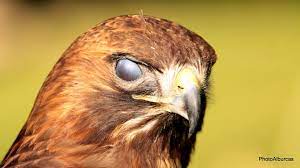What is the third eyelid of animals?
On any given day of bird watching in the Doñana National Park we can find certain animals that have this strange eyelid. Although it is worth mentioning that this third eyelid is actually called the “nictitating membrane.”
The word nictitante comes from the latin nictare, which means to blink. Blinking is a physiological action that certain animals need for different reasons. In this case it is an extra membrane to the well-known eyelids. It is shaped like a translucent membrane and can be found in different types of animals.
What function does it have?
This nictitating membrane has the function of protecting and lubricating.
The size, thickness and speed of movement is variable according to the needs of the animal.
Its function is to protect it from environmental aggression and provide lubrication to the cornea by distributing the precorneal film.
We can find this curious membrane in different types of animals, such as:
BIRDS
Within birds there are different types depending on their location:

- Membrane originating at the top, with movement from top to bottom.
-
Raptors and nocturnal: This membrane protects from any impact that may occur from particles in the air, especially when hunting, which can reach up to 300m/h without losing visual precision.
-
-
For example; peregrine falcon, Bonelli’s eagle, hawk, owls, etc.
-
-
-
Gallinaceae: originates in the lower part, with movements from bottom to top.
-
-
For example: Chicken
-
-
- Aquatic: for birds that spend a lot of time in the air and in the water, this membrane works as a shield against the impact of high-speed water, as it protects the entire anterior surface of the eyeball.
-
- For example: Kingfisher, seagulls, etc.
-
-
BIG MAMMALS
In this case, the so-called “third eyelid” has a large number of accessory tear glands. The only function here is to lubricate the eye.
Among these animals we can find the domestic cat, tiger or cow.
REPTILES

Other animals such as vipers do not have this nictitating membrane. But they have the so-called “shine or spectacle”. There are some theories that suggest that due to their way of life they do not need to develop related structures to sharpen their eyesight. So really, there are not many studies on this structure. It is only known that when they renew the skin, they also renew the so-called “shine”.
-
Bibliography
-
Duke ESS. The eye in evolution. Vol.I., England: Henry Kimton LD, 1958
-
Tista OC. Comparative anatomophysiology in fauna ophthalmology. Mexico: FMVZ, UNAM. APEC,1991
-
Prince J. Comparative anatomy of the eye. Llinois:Thomas Books 1956
Article by Elena Boa Martín.

